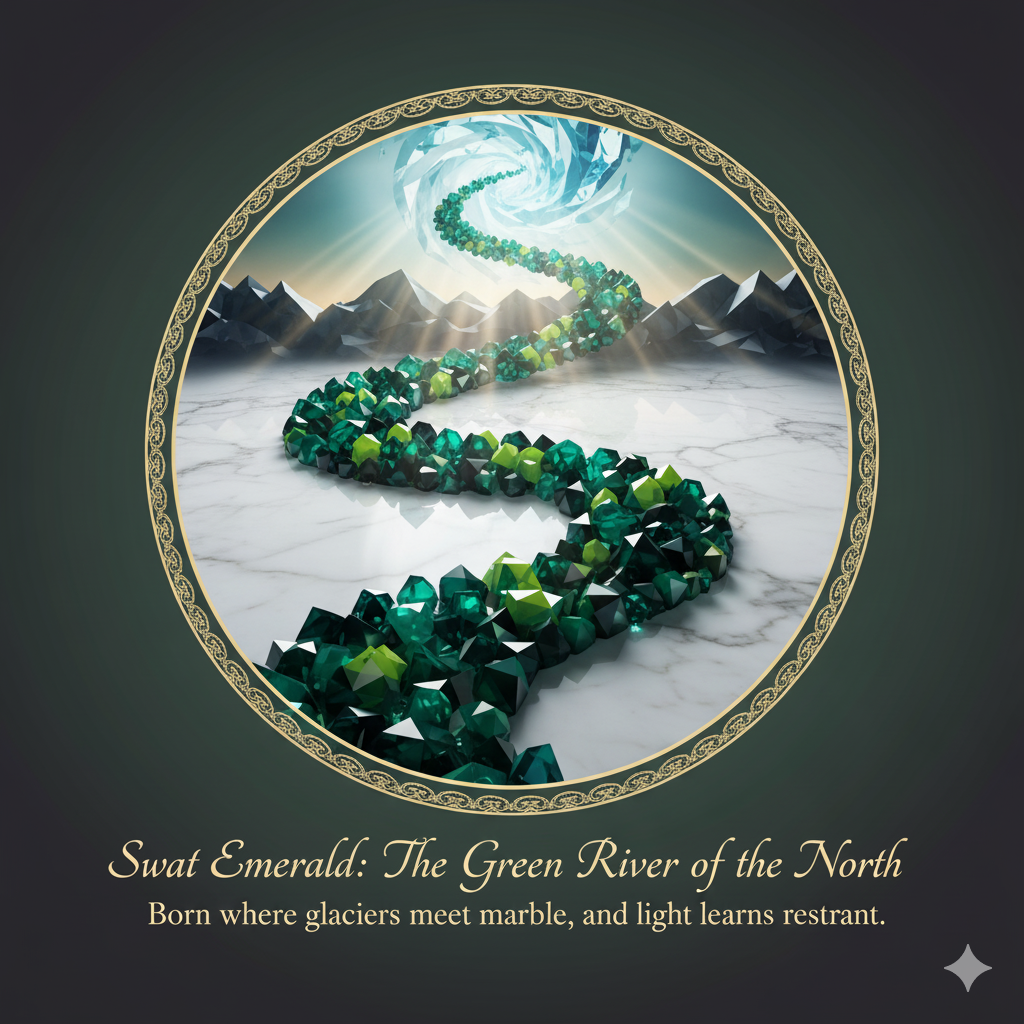Swat Emerald: The Green River of the North
Born where glaciers meet marble, and light learns restraint.
1. The Valley of Emeralds
In northern Pakistan’s Khyber Pakhtunkhwa province, between the snowbound ridges of the Hindu Kush and the river valleys of Swat, lies a land whispered about by gem traders for centuries — the Swat Valley.
Here, at altitudes of 2500–4000 meters, veins of green light trace through white marble cliffs, forming one of Asia’s most poetic emerald deposits.
The world knows them simply as Swat Emeralds, but in the gem trade, they are affectionately called “The Green of the North.”
They are smaller than Colombia’s, rarer than Zambia’s, and cleaner than most on earth.
Their colour — cool, open, vivid — captures the clarity of mountain air itself.
2. The Geography of Purity
The Swat emerald mines sit along the Shangla, Gujar Kili, and Mingora belts, approximately 100 km northeast of Mingora town.
They lie in the same metamorphic continuum that stretches across Panjshir (Afghanistan) — both born of the same Himalayan upheaval, separated only by political borders.
Geological Overview
- Host rock: Dolomitic marble
- Formation: Contact metasomatism between Be-bearing pegmatites and Cr/Fe-rich ultramafic rock
- Mineral family: Beryl (Be₃Al₂Si₆O₁₈)
- Coloring elements: Chromium and vanadium
- Formation age: ~25–35 million years
The white marble host gives Swat emeralds a brightness and internal glow similar to Panjshir, but with a slightly cooler bluish tint and extraordinary crystal definition.
3. Discovery and Early History
The Swat emeralds were first discovered in the 1950s, during surveys by the Pakistan Geological Survey and later explored by USSR mineral teams in the 1960s.
Mining activity began modestly at Gujjar Kili and Shangla, before spreading to the Mingora deposit — now the most famous of all.
By the 1980s, Swat emeralds were regularly traded through Peshawar, reaching Geneva, Jaipur, and Bangkok — quietly building a reputation for their crystalline brilliance and minimal treatment.
Even in rough form, their sharp crystal habit — hexagonal prisms with mirror-like faces — sets them apart from any other origin.
4. The Colour Language of Swat
Under daylight, a Swat emerald feels calm. Its green is not the lush jungle tone of Zambia nor the velvety depth of Colombia — it is alpine, clear, and tranquil.
| Attribute | Description |
|---|---|
| Hue | Pure green to bluish-green |
| Tone | Medium-light to medium |
| Saturation | Strong but not overbearing |
| Transparency | Excellent (marble-hosted clarity) |
| Fluorescence | Strong red under longwave UV |
| Typical size | 0.3 – 3.0 carats (rarely above 5 ct) |
The result is a colour that looks alive even in shade — a cold flame that flickers quietly rather than shouting for attention.
5. The Marble Advantage
Swat’s geology mirrors Panjshir’s: both are metamorphic, marble-hosted emeralds, as opposed to hydrothermal shale-hosted Colombian types.
Why does this matter?
- Low iron in marble allows maximum light transmission.
- High chromium content amplifies green intensity without dulling tone.
- Tight crystal growth within calcite veins ensures low fracture density and high polish potential.
Thus, while Swat stones are often smaller, they require less oiling and retain exceptional clarity.
6. The Microscopic Soul — Inclusions
Swat emeralds typically show:
- Three-phase inclusions (liquid, gas, crystal)
- Calcite and mica flakes
- Tremolite needles in fine, radiant patterns
- Growth zoning with faint parallel bands
Under magnification, they resemble mountain ice — clean, structured, serene.
To gemologists, this purity is diagnostic; to collectors, it’s meditative.
7. Mining the Impossible
Emerald mining in Swat remains entirely artisanal.
Narrow adits are dug by hand with hammer and chisel, following narrow veins through marble walls that are both brittle and sacred.
Mules carry out the rough; lamps and hope light the tunnels.
During winters, snow cuts off access for months, freezing production.
Yet, when the snows melt, the valley reawakens — and a few more grams of green find their way into the world.
8. Treatment and Integrity
Swat emeralds are admired for their minimal enhancement.
Light cedar oiling is typical; resin or polymer infill is rare.
Due to their clarity, “no oil” Swat emeralds are achievable and command high premiums.
Labs such as GIA, GRS, and SSEF regularly note Swat’s unique microscopic fingerprint and crystalline structure.
9. Market Trajectory
Over the past two decades, Swat emeralds have quietly entered the portfolios of high-end dealers and collectors, especially in Japan, Switzerland, and the UAE.
Though often overshadowed by Colombia and Panjshir, Swat’s reputation has grown steadily due to:
- Consistent quality
- Limited production (≈20–25 kg rough per year)
- Untreated purity
Fine Swat material now trades between $3,000–10,000 per carat, with top gems exceeding $25,000/ct for stones above 3 carats.
10. Auction and Recognition
While Swat emeralds appear less frequently at auction due to their small size, notable highlights include:
- Bonhams London 2021: 4.32 ct vivid green Swat emerald — USD 62,000
- Christie’s Geneva 2023: 3.89 ct un-oiled emerald, AGL certified — USD 71,000
- Private Geneva Trade 2024: suite of 11 matched Swat emeralds (total 7.8 ct) sold for USD 110,000
The world’s top connoisseurs now describe Swat emeralds as “Afghanistan’s calm twin.”
11. Swat vs. Panjshir — Sisters Across the Border
| Attribute | Swat (Pakistan) | Panjshir (Afghanistan) |
|---|---|---|
| Tone | Lighter, cleaner | Medium-dark, richer |
| Hue | Bluish-green | Pure green |
| Clarity | Exceptional | Very good to excellent |
| Fluorescence | Strong | Moderate |
| Size range | Small to medium | Medium to large |
| Treatment | Light oil | Light oil |
| Character | Cool, calm, crystalline | Deep, spiritual, luminous |
Swat is daylight; Panjshir is twilight.
Together, they form Asia’s emerald duet — one rational, one emotional.
12. The Human Element
Mining families in Swat have inherited the craft across generations.
Children grow up distinguishing mica from marble, mothers weigh rough on kitchen scales, and fathers trade parcels in Mingora’s small gem bazaar — where deals are sealed with tea, not contracts.
These emeralds are not corporate; they are personal.
Each gem carries fingerprints of both geology and family.
13. Cultural Significance
In Pakistani tradition, emeralds are associated with intelligence, calm, and divine vision.
Sufi mystics believed the stone opened the heart to truth.
Even today, emerald rings are gifted during major life transitions — education, marriage, spiritual devotion — as tokens of balance and peace.
Swat emeralds thus hold both economic and emotional weight in local culture — symbols of prosperity, intellect, and beauty without ostentation.
14. Challenges and Preservation
Despite their beauty, Swat mines face constant threats:
- Unregulated artisanal mining causes occasional accidents.
- Political instability sometimes interrupts operations.
- Climate impacts (heavy snow, landslides) reduce yearly output.
Yet, each time the world assumes the valley is silent, miners return — chiseling eternity one crystal at a time.
15. Why Collectors Seek Them
Swat emeralds appeal to those who value restraint over grandeur:
- They’re small, but perfectly formed.
- Unheated, ethical, and historical.
- They represent clarity in chaos — nature’s most disciplined expression of green.
To own one is to hold a piece of stillness — a fragment of the Himalayas’ breath.
16. PreciousCarats Reflection — The Green of Discipline
Swat emeralds remind us that beauty does not have to overwhelm.
Their glow is not the drama of light, but the discipline of it — quiet, balanced, aware.
They are what happens when the earth chooses grace over spectacle.
In the language of gemstones, they are a whisper that still fills the room.
From marble and snow, the Swat emerald emerges — clear, patient, and eternal. The mountain’s meditation turned to stone.

